It has to be said that the Infinite Machine Olto e-bike gives off Cybertruck vibes, though it’s small and kinda cute. The under-$3,500 “Class 2” contender, designed to conquer urban bike lanes at 20 mph and to be released in October, is the second product from the Queens-based Infinite Machine, following a similarly styled but much bigger $10,000 P1 scooter first shown last year. Here’s a quick look at what it was like riding the Olto.
Scooters aren’t allowed in New York’s bike lanes, so the brothers designed a bike with regular assisted pedals, but those pedals can also be locked in place as footpegs for a scooter-type ride. Top speed in the lanes is a governed 20 mph, but via its two-kilowatt rear hub motor the Olto can be liberated to do 33 mph off road. Range is 40 miles from a removable 20-pound, 48-volt 1.2-kilowatt-hour pack that charges in six hours, or goes from 10 to 80 percent in an hour with the optional Supercharger. Also optional is a home dock so you don’t have to plug in.
The company was founded by two brothers, Joe and Eddie Cohen, initially in Brooklyn. Innovative industrial design is their thing. Both Cohens studied product design at the University of Pennsylvania’s Wharton School, and are obsessed with building better transportation vehicles. (That’s what they call them, “vehicles.”)
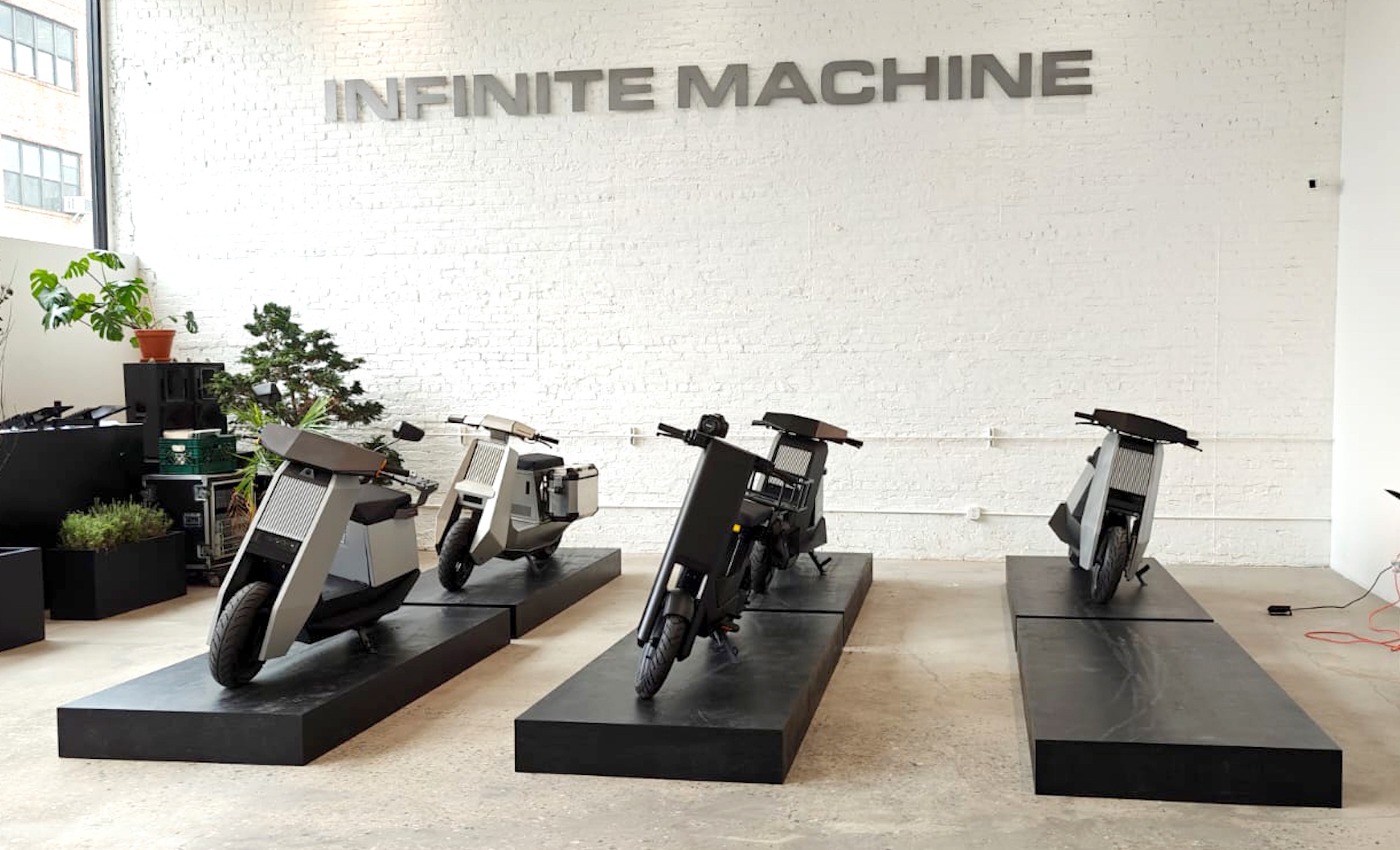
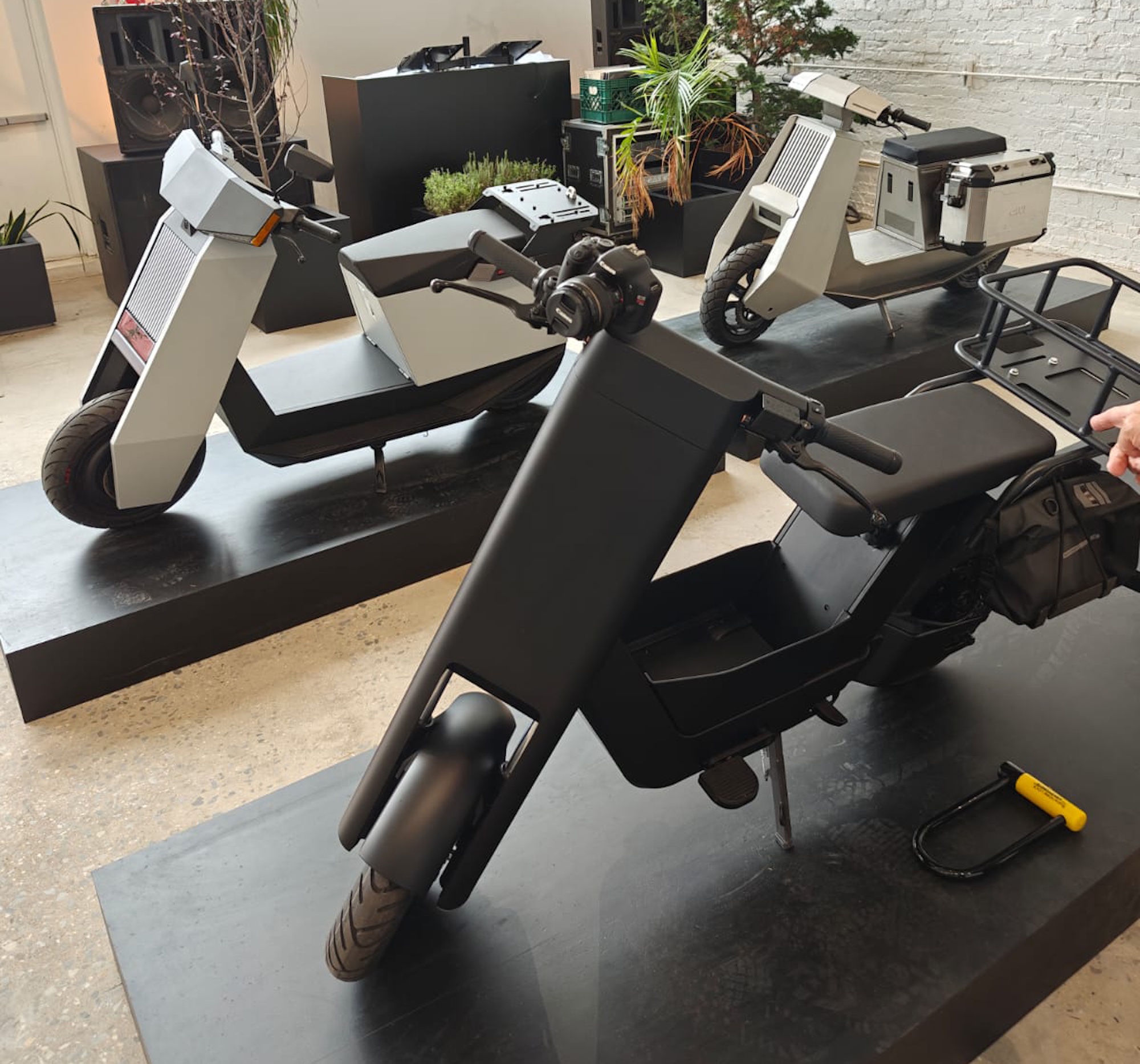
“Most e-bikes are based on regular bicycles, and that’s limiting,” said Eddie Cohen, the spokesman. “They have bicycle-type gearshifts, when you don’t really need that when your power is coming from electric motors.”
The Olto is definitely based on out-of-the-box thinking. It has a non-adjustable bench seat that taller people can adapt to by sliding their butts rearward, and a second person can potentially ride, too. The Olto is built of industrial-grade extruded aluminum with all wiring encased. It has reverse, and the headlight has a “bright” feature. GPS is built-in, as is a camera that can take video and still pictures. The seat lifts up for storage, and putting the kickstand down triggers “park.” The driver can’t take off with the stand down.

The Cohens claim that the Olto can be stored outside and is virtually theftproof. “The handlebars can’t be turned when Olto is off, and if you try to roll it away it goes into reverse and the wheels lock up,” Eddie said. If the bike is somehow moved, GPS will track its location and an alert goes to the owner’s phone. An included bike lock threads through a loop in the kickstand. There’s also a special compartment for Apple AirTags. The security works even if the main battery is out for charging (there’s an auxiliary).
Turn signals sound through the hidden speaker, as does the loud horn (no kids-bike-type bell here), and there’s also a backup warning sound when in reverse. There’s a USB port for charging, a phone attachment point, and an optional Bluetooth-enabled speaker can be strapped on. Bluetooth can also unlock the bike via your phone when you walk up to it.
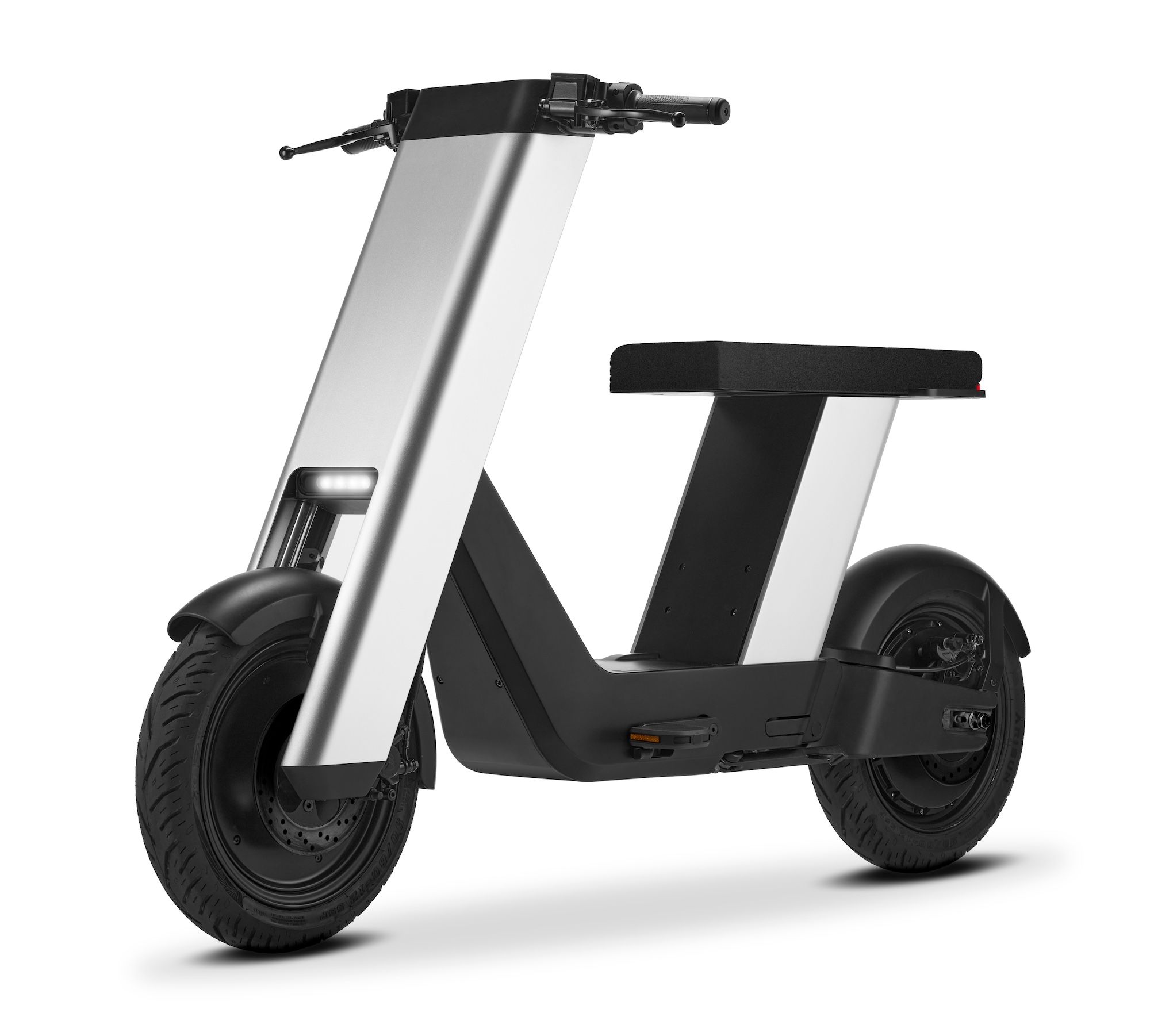
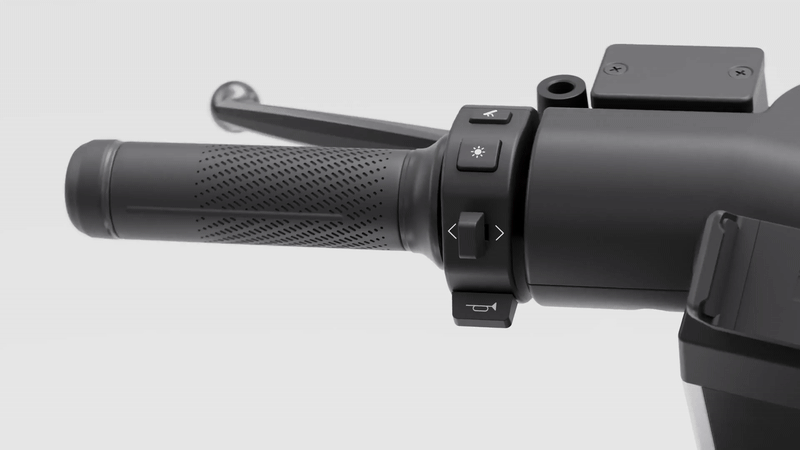
It’s fair to say that the average e-bike doesn’t have all these features. But how is it on the road as an actual bike? The prototype Olto didn’t have pedal assist fully worked out, so I rode it in scooter mode. I was able to get comfortable on the bench seat, and rested my feet on the pedals. Instead of a gear shift, there’s regular driving and a temporary “boost” mode.
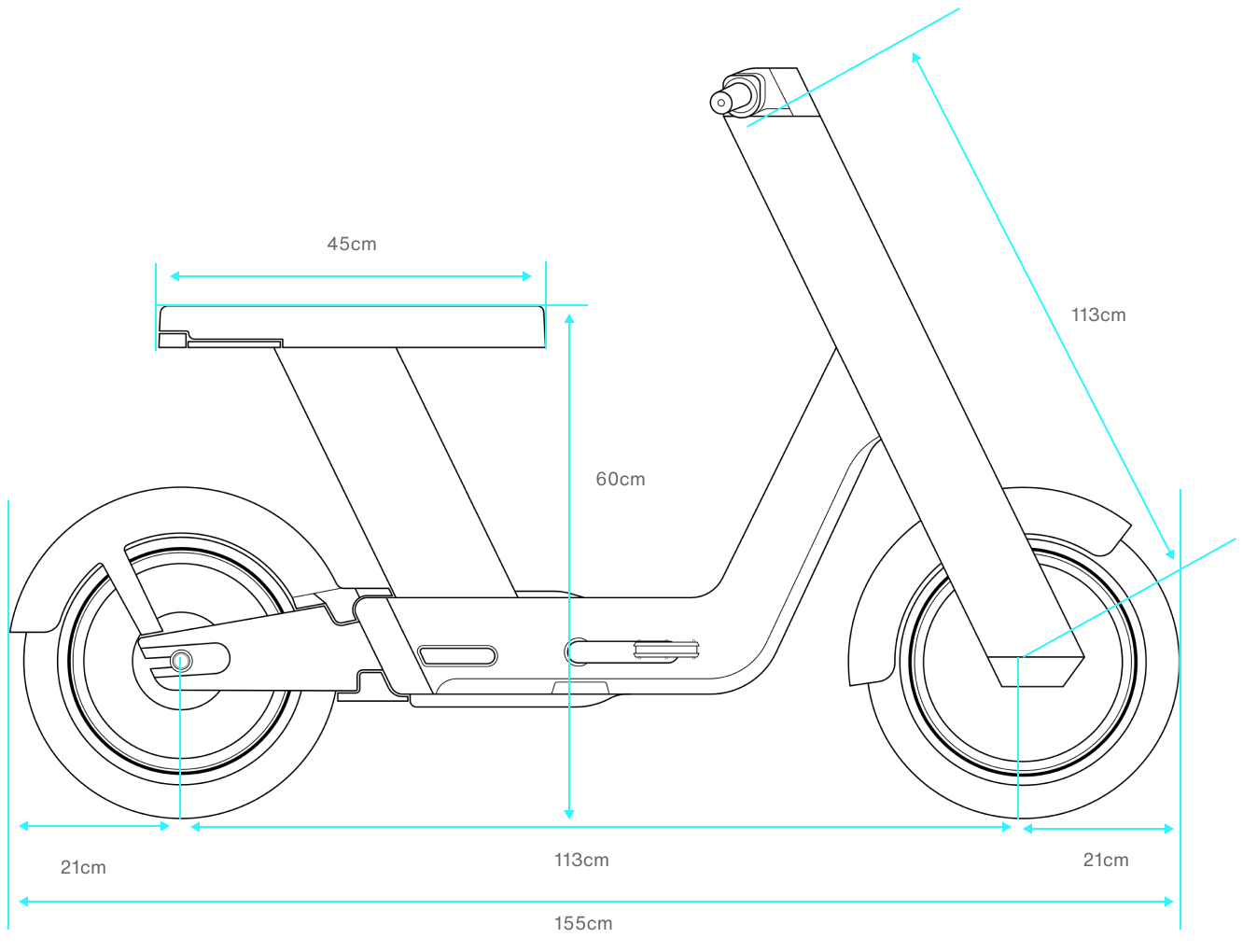
The 176 pound bike has a motorcycle-type twist handlebar accelerator (sometimes it’s a peg) that’s easy to use, hydraulic disc brakes and both front and rear suspension. The ride remained well-damped on Long Island City’s cobblestones. I was confident in using the bike within 10 minutes, though not enough to try out boost mode.
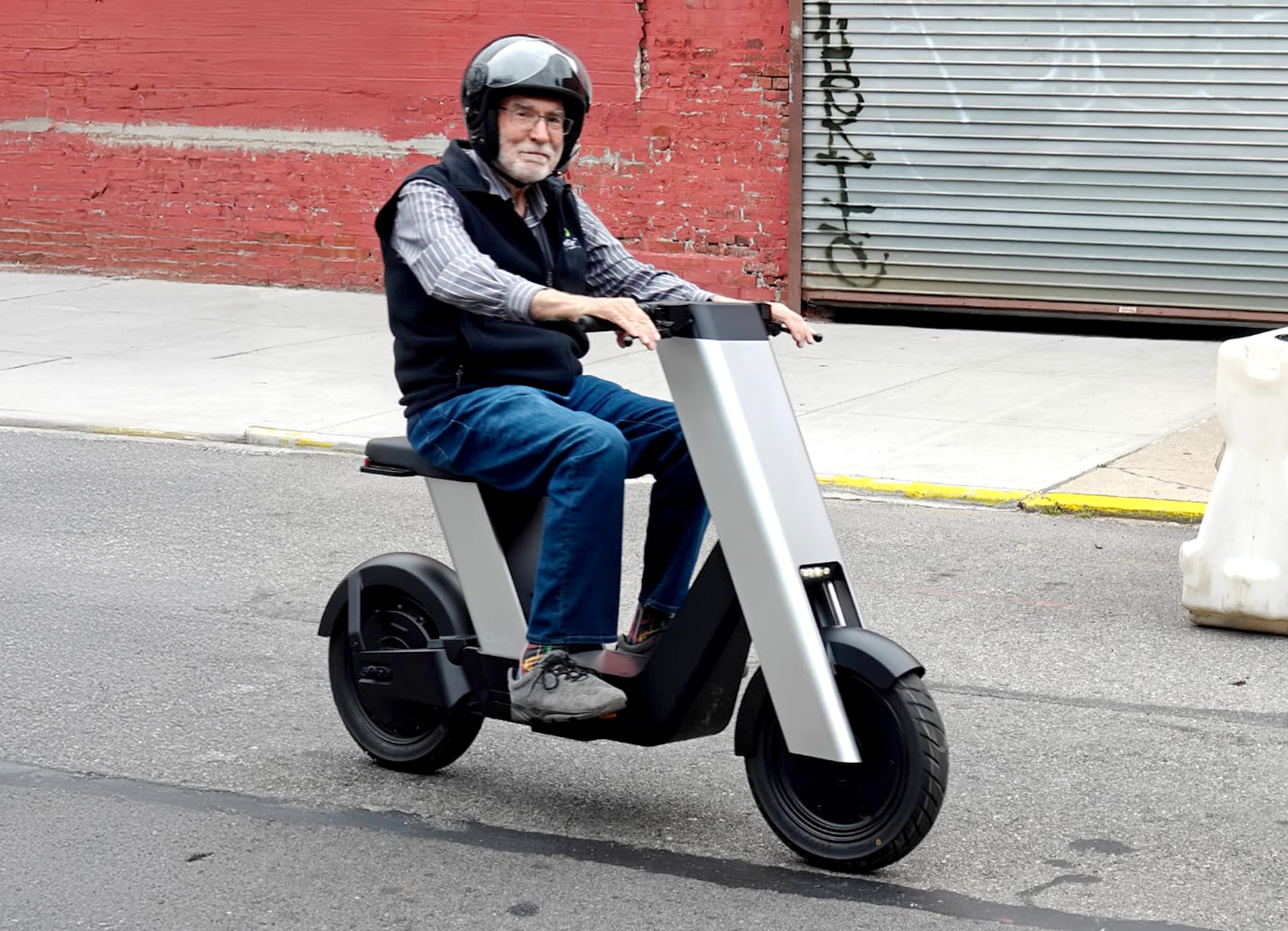
I brought along my cousin Ben, who is 6’8”, to see how he’d fare on the Olto. He could ride it fine, but reported that the stoplight resting position was a bit awkward. “I thought it was a little small, but I don’t represent most people in that regard,” Ben said. “A slight lean when moving at street speed became precarious when slowing down to near-zero, magnified by my altitude. Gravity was not to be outdone. It’s not really a critique of the bike, though—it’s an issue for me on any two-wheeled vehicle.”
The Cohens traded a small office in Brooklyn for a large warehouse with a back door that opens onto the Anable Basin, an inlet of the East River. The company now has 13 employees, and two of them were fiddling with a bike on a stand during my visit. There’s a 3D printing room, a workroom with a plasma cutter, a CNC machine, a sandblaster and metal-bending tools. A cool and tiny Japanese-market Subaru 500-cc Sambar truck stands ready to move stuff around. The team makes small parts (“anything low volume”) such as kickstands in-house, as well as the occasional whole vehicle and prototype accessories—a child carrier, and various add-on storage racks.
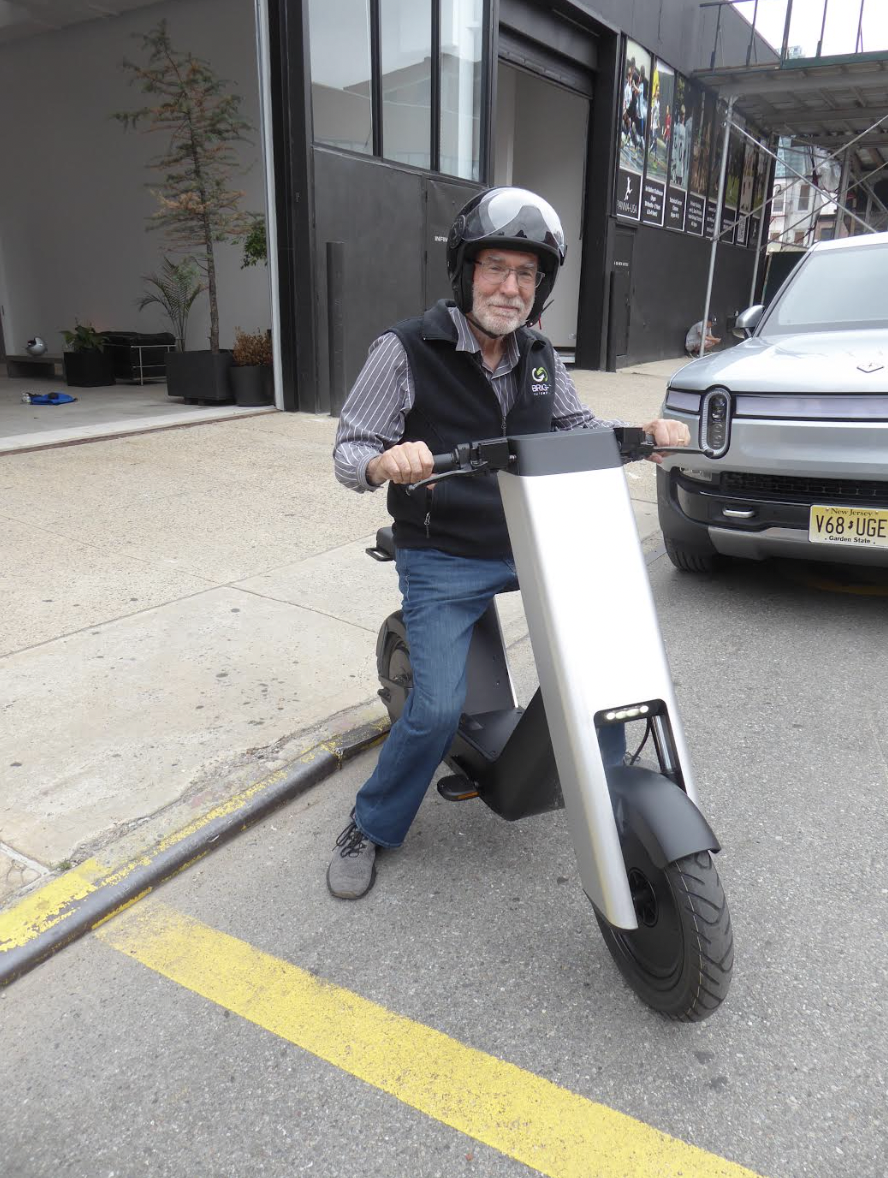
The Olto is made in China, so I asked if the tariffs were an issue. He nodded. “We’re moving production to Malaysia, which also has tariffs but not as big,” he said. I asked for his opinion about the rapidly changing tariff picture. “We don’t do politics,” he said.
Standing by the churning basin, I suddenly thought of the Amphicar, that oddball German 1960s contraption that was half-car, half boat. “What about a scooter that can swim?” I said. “We’re working on that,” Joe said. I think he was serious.

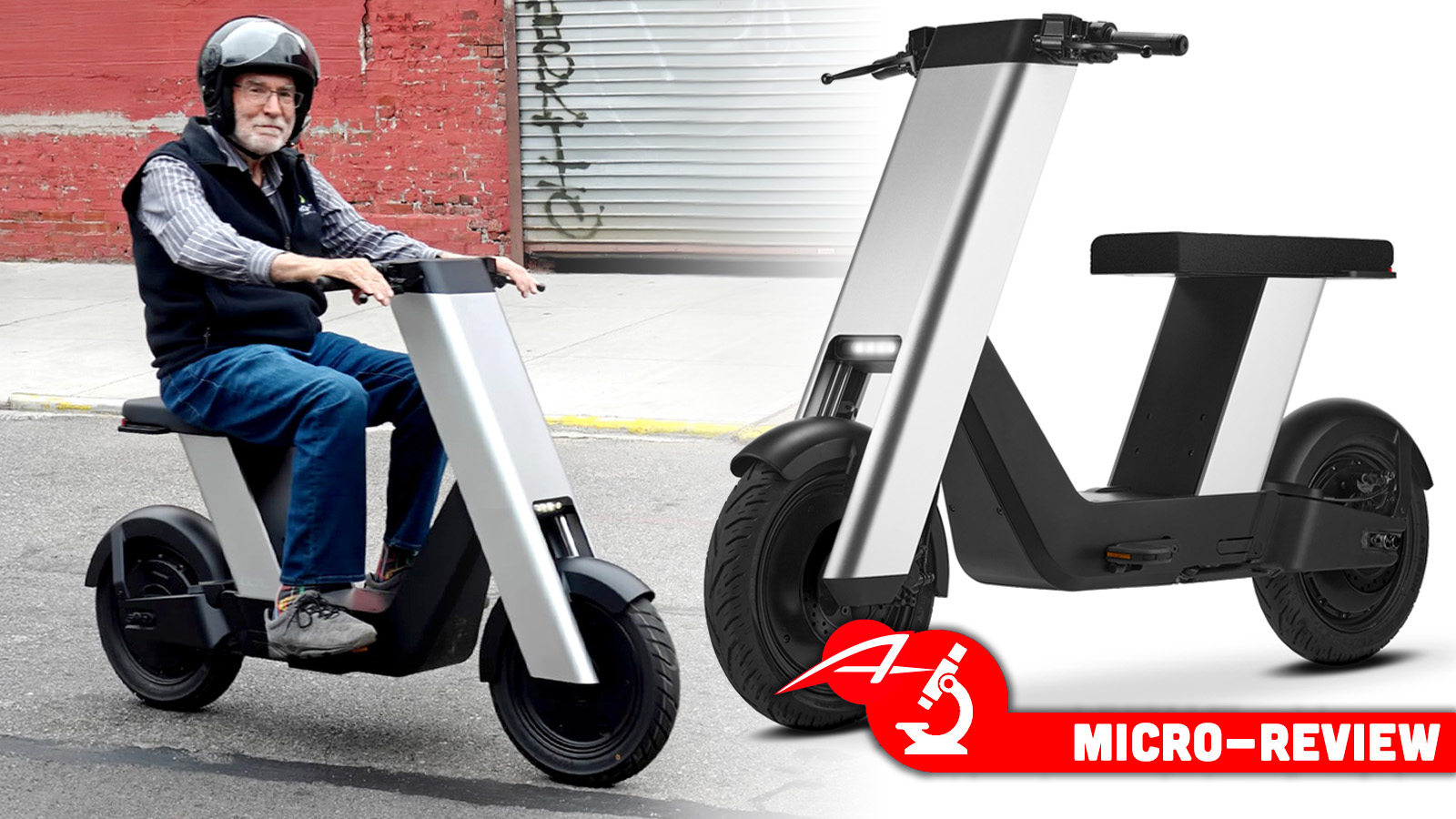







Just call it what it is; it’s a moped and it should be treated as such (legally speaking) by states. I believe that means (in most if not all states) that it would require at least a driver’s permit, as well as a registration and insurance.
I don’t hate the product itself. I hate that they are trying to pawn it off as a electronically assisted bicycle by thinking they are clever with a loophole. Like no one has thought of this before; no, you aren’t smart, you’re just being disingenuous. Loads of people have thought of this before, but they likely haven’t ventured into it because of moral and ethical reasons…
The fact this comes off as a puff piece is a bit disappointing. They should really be called out here, or at least mildly challenged on what they are doing.
No disagreement with anything you said, but the 2KW motor disqualifies this thing as an E bike in all US states but 2 (FL and MS) – so the fake pedals are completely irrelevant. I have to believe that the author of the article doesn’t understand what he’s representing here – the “brothers” can’t be that dumb… but then again, they did put useless pedals on a scooter, so…
From my own experience sharing my local bike path with people doing varying degrees of stupid shit, I can say with some certainty that the demographic who is attracted to an overpowered 175-pound cyber scooter with fake bike features will have strong overlap with the demographic who is too cool to wear a helmet. So maybe the problem of sharing a bike lane with this scooter will just solve itself.
Why does it have to look like *that*?
Any “bike” with no saddle adjustable height and a flat bench seat was never meant to be peddled. That aft adjustment is in no way sufficient, as aft mainly effects reach. Your butt moves while you pedal. And its going to move a lot because the saddle is so low, and unless your tiny, you’re bringing the knees way above the hip. That’s a whole lot of friction between the ass-skin and the saddle. It’s a chaff-machine. pedal this thing five miles and you won’t sit for a week. It’s pretty clear whoever designed this wanted a scooter. Because this is missing even a basic understanding of how the motion of cycling actually works. It’s like a bike designed by a person who has never actually ridden a bike.
I think they’re peddling it just fine, just not as a pedal-bike. 😉
Hey Cohen bros… I know that you were excited about your, ahem, “bike” being featured in The Autopian, but you are really pissing off those who want to safely commute in a bike lane. This is a disingenuous effort to skirt the law and put a throttle scooter in a bike lane where it does not belong. Those faux pedals are really pissing me off. A collision in a bike lane is bad enough but adding 100+ lbs to this thing endangers people even more. Please stop…
Agreed. This is a scooter with pedals, not a bike with a motor.
They sound like the epitome of the loser tech bro “disrupter” trope that really just skirts laws and claim to be revolutionary. Hell, the second to last paragraph where they respond with “[they] don’t do politics” when asked a question core to their entire business says it all. They aren’t really doing anything better, they are just trying to dodge as many laws & regulations as possible.
Their comment tells you all that you need to know. Hw can you not have an opinion on tariff policy that will hurt you? Also, I don’t see them moving production all that quickly…
I went to their website and while it says “built for the bike lane”, the video shows a rider veering out of the bike lane and into traffic in front of a cab! Yeah, these guys can eff all the way off… and keep going.
“The Olto is built of industrial-grade extruded aluminum…”
They missed a trick there, artisan-grade extruded aluminium would sell for twice as much. /s
Please tell me you copied this phrase out of the press release and didn’t invent such a meaningless adjective. Were all the military grades and aerospace grades taken?
I spend a lot of time selecting the appropriate grade of aluminium and steel (and occasionally titanium) and they’re all “industrial”.
I picture artisanal extruded aluminum being manufactured by hipsters melting down their empty PBR tall boys over an open fire.
And their extrusion press is powered by a unicycle.
With that low seating position and a 90 degree on knee bend, you wouldn’t get much go out of pedaling this thing. This is like a mild PHEV with five miles of range- it’s a compliance powertrain. Looks like a nice ride, though. Very sexy for a mobility scooter!
It’s fine but it needs 3000 watts and to just be a motorcycle.
I kinda like this thing. Paint it to look like it came from the movie Tron! Blue or red, it would look cool.
In China the closest thing I have seen to this…compliance pedals, inflexible seating and all…are the Meituan and Hello Bike rental e bikes. They are limited to 25 kph, about 15 mph. They get the job done. 20mph would be reasonable and is typical of the low end of privately owned chinese ebikes.
A nationwide standard legal vehicle class, with a weight limit, no requirement for vestigial pedals, and a top speed limit in that range would be a good thing. Fast enough to be useful in American cities (similar speed bikes are used.in the Chinese countryside), not fast enough to be much of a threat, and no fucking pretense.
The pretense is a New York thing, the awesome part about federalism in the U.S. is new York can have these rules but in some random town in Wyoming you don’t.
NYC has different ebike and scooter laws than the rest of the state.
The lack of unified standards is holding the industry back in the US, keeping things boutique and expensive.
In other states they require them to “assist when pedaling”
The bike is doing almost all the work in these cases. It’s still a pretense, except now you’ve excluded a lot of disabled people.
“The Olto is definitely based on out-of-the-box thinking.”
No it isn’t. This has been the standard model for Chinese ebikes for over a decade.
I don’t really get the harsh comments.
I’m not a fan of the looks either, but that’s subjective I guess.
This thing is an evolution or continuation of the ’70s-80s 50cc mopeds.
That category of vehicles, in the US, and many other countries, also came with pedals. And the pedals were mostly there to kickstart them and because they were mandated by regulation.
This is essentially the same thing, just not 2 or 4 stroke 50cc, but electric.
Isn’t that better for everyone?
Quiet, doesn’t smoke, does about the same speed, costs roughly the same, if a bit more.
Maybe you didn’t read the comments. If it were intended for use on the street, nobody would care. But the pedals aren’t there for any reason other than to skirt the rules, so it can be used in bike lanes. Riders will simply use it as a scooter to haul their lazy asses at 30mph in spaces where that is incredibly dangerous.
50cc mopeds with pedals can be legally used in bike lanes. So again, how is that any worse than those?
No, they absolutely can not. While some areas permit mopeds in on-road bike lanes, they are not allowed on bike-specific or mixed-use trails (including sidewalks) where Class 1 e-bikes are permitted.
The point of this scooter is to circumvent the rules by claiming to be a bike rather than a moped or scooter, so it can be ridden in the spaces where e-bikes are allowed and scooters/mopeds are not.
Class A mopeds (exceeding 30 mph) require a license, registration, and insurance in NYC and cannot be used in bike lanes. Class B mopeds (under 30 mph top speed) do not require insurance. Either way, this thing should require a minimum of registration and license and not be allowed in bicycle lanes.
A moot point, because I agree that this is trying to take advantage of a gray area, but:
Class B mopeds (like the one in the pic next to my handle) still require insurance in NY. Class A adds a requirement for a motorcycle license and for annual safety inspection (it’s essentially counted as a motorcycle that can’t go on the highway). Class C is below 20mph, but if I remember correctly they still need insurance and a license plate if they are a gas-engined scooter. NY says to ride a “motor vehicle” on the road, it needs a registration and insurance and a plate. E-bike laws were put in place a few years ago because the rules previously only allowed for pedal assist bikes (otherwise they became a “motor vehicle” and would need to be plated). Now there’s a weird space where you can have an electric scooter without pedal assist that lives in the same space as a gas scooter, but one needs insurance and the other doesn’t. It’s all a bit twisted.
Exactly this. I’m a cyclist and cheap non pedal-assist throttle e-bikes are becoming an unregulated menace. Dangerous AF in bike lanes as jackasses who are too lazy (sorry, not sorry) to at least ride a pedal assist bike are going too fast and with not enough of an understanding of bike etiquette. Additionally, I’m seeing them merging with motor vehicles on regular roads. I’ve seen a ton of kids riding these essentially as unregistered motorcycles by unlicensed drivers alongside cars, truck and other motor vehicles. Also, this one is particularly stupid with it’s seemingly fixed seat height and horrible ergonomics.
As others in the comments have noted, this device isn’t a bike and is specifically designed to menace people using bike lanes and sidewalks. The entire form factor, from its weight to its riding position, makes it obvious that the pedals on this are simply there to circumvent the rules in place to keep bike lanes reasonably safe.
What is especially stupid about the “Infinite Machine” (which has to be one of the most ridiculously pretentious names of all time) is that it doesn’t even do a good job of being an e-scooter. The market is full of options that are lighter, less expensive, have a longer range, and forego the pseudo-advanced features like the hooks under the seat for actual functional elements that have been shown they work over millions of miles of real-world testing.
This thing represents the absolute worst of what comes out of industrial design as an industry. It is all based on a combination of arrogance and ignorance.
It’s these hack stylists masquerading as designers that are only good at selling themselves that turned me off to ID. A designer should understand how a product is used, think of how it can be improved, and make it more salable through aesthetic packaging. These guys throw together a cynically-marketed, mediocre, derivatively-styled, 1st year project and throw in some simpleton hashtag software features that impress the clueless when coupled with the stereotypical pretentiousness of the bottom-of-the-class “designer” because it’s easier for the talentless to sell a BS image than it is to actually do something of value. Of course, that last part sums up most of the world we live in now which explains my general state of disgust and desire to see our extinction.
And that, fellow misanthropes, is how you can take a bland scooter of no relevance and turn it into a condemnation of all of humanity. Perhaps that’s my talent. Too bad nobody’s buying it, but I don’t care as long as they aren’t buying these scooters!
This is the perfect rant.
Thank you. Coffee kicked in. I’m not nearly as miserable as my occasional rants might make me seem, it’s just my odd sense of humor that doesn’t come across nearly as well as written word as it does in person.
I got an undergrad degree in Industrial Design, so it hit home. When I was in college, I met the guy who had recently designed the first Trek “Y” frame bike. The original design was a college project of his that got him the job at Trek. He was very open about the fact that he had no idea what he was doing and just thought it looked cool. It sold like hotcakes and won awards, but it was a terrible bike that lost huge amounts of energy while pedaling due to the frame/suspension design, among other fundamental flaws.
The designer had no experience cycling; he and Trek manufactured B.S. reasons that the design was great after the design started getting attention.
And so many imitated it! I had a Giant imitation in the late 90s, and yeah, single pivot resulted in a lot of bobbing when climbing. TBF, though, that was early in full suspension design and it was a simple solution even if it wasn’t originated in function. Trek should have known what they were getting and done more development. I have wondered if it turned more people onto mountain biking because of the looks or against it because of the bobbing, but I decided I didn’t want rear suspension on my next mountain bike. Never got another one, though, as I ended up realizing that I didn’t enjoy mountain biking all that much as this whole area is root-and-rock technical trails, which is slow and requires more skill than I’m willing to put the time into because it means spending a lot of time getting hammered by insects while dripping sweat and hoping to get back to AC before dying of heat stroke in the high humidity. Freezing in the winter was better, but still not that fun to me.
For me, I designed a couple small boats, but I know enough about naval architecture to know that I’m not a naval architect*, so I bought licenses for a couple different hulls that fit the characteristics I’m looking for (relatively narrow and low-ish deadrise for efficiency) to build off of. As Dirty Harry’s writers once said: a man’s got to know his limitations.
*I did build a model of my own design prior to looking for real ones to see how far or close I was naturally to a viable design and I’m pretty sure it would have rolled over and sank in short order.
The Y-frame was an early attempt, for sure, and I have no issues with an imperfect start. The shocking thing was that both the designer and Trek were aware of the issues and simply made up excuses to sell it rather than addressing the problems. I started in ID doing stuff like small appliances and inline skates back in the ’90s, but got tired of the combination of ignorance and pretentiousness that seemed to be a requirement to advance. I bounced around everything from interior design, graphic design, and architecture before getting old enough that I could get hired doing “strategy.” Whatever that means at any given moment. Mainly, it is finding polite ways to tell people not to do the things they want to do.
As for cycling, I never got into mountain biking, but in the riding season here, I put more miles on my bike than my car. I have a cheap cargo e-bike, a nice gravel bike, but the bike that gets used the most is what was a top-of-the-line Schwinn from the 80s. It is simple, never breaks, and I can lock it up without worrying. The best part is that where I live, I can typically get about 8 miles across town on the bike more quickly than driving.
My dad built wooden boats, and a friend from college had a job building custom boat interiors in Sweden for a bit. A friend used my garage years ago to build a small speedboat with plans from Glen-L. It was a hoot.
I figured out early on that ID was as much about selling oneself than actual ability and designing cars was going to be not much money to work on boring sedans (it only got worse since then) and that anything I’d actually want to design would have limited appeal as I’m most inspired to design something when it isn’t already available whereas most design tends to be variations of what competitors are doing.
I went through a phase of building unusual bikes. I built an ACME rocket bike that started as a joke mocking insecure dudes who wouldn’t ride an antique “girl’s frame” even though they liked them and that has ended up being my most frequently ridden bike because it brightens the days of just about everyone to see it. I started a midmount ebike a few years ago, but it’s sat since then. I need to get back on it, but too much stuff has taken precedence.
I commuted for a year on an old Reighley three-speed, and it was great. Slow, but great. No worries about not having current gear, and the fact that it was a lot more work to pedal just meant more exercise!
My Mid Century custom has an SA 3-speed coaster (with a disc front brake). I built the shifter as a dial in the tank that kind of looks like a fuel tank filler cap. The bike looks much better than it rides (feels even heavier than it is), but it’s a cruiser, not a distance runner. I mostly leave it in the middle gear (1:1 IIRC)
Wow! That explains a lot! Those Y frames and the myriad of copies were just awful bikes in terms of pedaling efficiency. Mountain bikes in particular have evolved in the three decades that I’ve been riding them. The industry often sold half baked concepts and then tested them out on the (me included) gullible public. The geometry for instance- long stems and narrow handle bars. That put so much weight forward that endos were a multiple occurance on any group ride! But we still rode. And then the geometry evolved with short stems, wider bars and higher bottom brackets and slacker forks, etc. Rear suspensions have evolved (DW Link, VPP) and now they are so efficient in pedaling. It was a bruised, bloody, broken bone journey and I’m glad that modern mtb design has evolved to where it is today.
The part that is especially noteworthy is that bike fit is far more important than any mechanical feature, and yet many people don’t bother to do it correctly. I’ve loved cycling since I was a little kid, and I am over 50 now. It was just about 10 years ago that I found somebody to do a proper bike fitting. It was a game-changer. No matter how many tutorials you look at, having somebody who really knows what they are doing do a fitting makes a huge difference.
I’d say that both bike fit AND getting rid of inherently dangerous designs are important. I’ve embraced both!
“…but via its two-kilowatt rear hub motor…”
Not street-legal as an e-bike in most US states (including NY), so the fake pedals are irrelevant. A half dozen states allow 1000 watts, and the rest (except FL and MS) are 750 watts max. Not sure what these guys are thinking…
Yeah bad ideas as design choices.
1. At 168 pounds it can be picked up and placed in another vehicle. Don’t tell me GPS Tracking can’t be fooled
2. The two best safety devices are it’s ugly and the battery is removable. Advertised for ez charging but anti theft as well
3. Universal one spot seat means it won’t be comfortable for 90% of the drivers all day.
4. I owned a moped I will bet you can’t operate this on pedals only.
5. I bet somewhere some garage mechanic has or can redesign a ICE minibike to electric that is better than this for half the price.
I just came back from cycling on a BICYCLE where you provide your own motivation. I’d be pissed off if this scooter thing was in my way or zooming around me. Too powerful, too heavy, not a bike, looks stupid.
Try again.
Industrial design my butt.
100% agree. I put more miles on my bike than my car during riding season and am lucky enough to live somewhere with lots of bike lanes. E-scooters using bike lanes pose a huge danger. People zipping around on 100lb+ scooters with their headphones on, traveling at speeds of 10-20mph faster than any other cyclist, and weaving around people riding with little kids pose a huge danger.
Depending on your local bike classifications that might be illegal and a good ticketing opportunity for the cops.
This is what 90% of ebikes in China are like (but with better seats), and dealing with them as a cyclist isn’t really a problem. On sidewalks (in Shenzhen ebikes ride on the sidewalks. no bike lanes), as a pedestrian, they are no worse than bikes (which is to say they are a pain in the ass, but I never saw an accident).
This is why I vehemently oppose class 2 e-bikes. Throttle operated 2 wheelers are basically motorcycles and should be regulated the same way. The system of locking the pedals is just like the old “Sports Mopeds” that were small motorcycles in all but name. The Olto looks and acts like an electric Vespa and should be licensed and operated like a 50cc motor scooter. The designers themselves say they deliberately moved away from bicycle design.
The hill I’m prepared to die on, if I don’t get wiped by a teenager doing 50 on a bike path is only pedal assist e-bikes should be allowed on bike paths, bike lanes and off road trails. Any throttle operated e-bike should be treated like a gas powered vehicle.
As an object this seems like a great way to pop down to the shops or commute in a city, but only with a license plate and liability insurance and a motorcycle operator’s license
This right here. Stop calling it a “bike”, it’s an electric scooter with pedals designed only to meet the minimum letter of the law to qualify it as a “bike”, and they will never, ever be used.
Nonsense.
Spot on. I hate this thing.
I am in 100% agreement with you, if it has a throttle its a motorcycle!
Do I need to wear my dork badge when on this?
That’s what they call them, “vehicles.”
And why wouldn’t they? A “vehicle” is by definition “a means of carrying or transporting something”.
https://www.merriam-webster.com/dictionary/vehicle
By that definition a shopping cart is a vehicle. So is a backpack.
What about a scooter that can swim? Water scooters usually go by the moniker personal watercraft and they’ve been around for quite a while:
https://en.m.wikipedia.org/wiki/Personal_watercraft
From my cat’s perspective, I am a vehicle as I carry her to breakfast. (She’s 6.5lbs and in no need of exercise, but enjoys it regardless).
Seems like a lot of heft for something to ride in an bike lane, vs an actual e-bike.
No offense to the brothers(offense incoming) but ground up designing something to take advantage of a loophole in the law is a recipe for disaster, as they can update the law with a quick flick of the pen, and then nobody can ride these in a bike lane, and redesigning/retooling isn’t nearly as quick.
Also does it have any suspension? For the weight I would hope so, but the frame on the back looks continuous to the wheel, that’s a bumpy ride at 33mph.
“…hydraulic disc brakes and both front and rear suspension…”
“designing something to take advantage of a loophole in the law is a recipe for disaster”. And “assholic”
This is not an e-bike, it is a moped and does not belong in bike lanes.
As it’s nominally governed at 20 mph, it’s also a hazard outside of the bike lanes.
I really can’t find a use case for this. But I have a bicycle, a gas scooter and a car, so perhaps my vision is limited. I’ll be interested to see how and where they end up. And I wish the brother Coen well.
Heavy, especially for a place where people might want to bring it in and out of apartments multiple floors up. I guess that’s part of the security. It’s really a scooter that cosplays E-bike by meeting the technical letter of the law (well, at least that’s the plan). Seat does not look long-ride comfortable which, I would think should factor into the design brief behind this. Not a fan of the design. It’s too clean—clinical, has no personality. It looks very “this was an underclassman project I did in ID studio”. Though, now I wonder if I should build a working version of my ancient spider plant-inspired coffee maker … no.
Cycling Autopians, question for you all — I don’t have much cycling experience, and none on e-bikes, so I’m curious: how does this compare in heft and use case to more “conventional” bicycle-framed e-bikes?
176 lbs and around $3500 is within 50 lbs and $100 of a 2026 Honda Grom.
It’s heavy, like well over double the weight of a heavy e-bike and an e-bike has a removable battery that makes them lighter when they need to be hefted around. OK, this one is removable, too, but it still only gets it down to about 155 lbs. and 20 lbs. can be a lot for a lot of people, especially if they’re carrying it up multiple flights of stairs. This is a scooter pretending to be an e-bike that’s too heavy to be taken in and out of any place that’s not ground level for many people, transported on bike racks, and I can’t imagine too many people are going to want to heft it in and out of a truck bed. They could use a ramp, but then why not get an honest scooter or motorcycle? I have a 2″ receiver and this thing not only exceeds the weight rating of my Kuat rack, but even the tongue weight of the receiver when factoring the rack weight and distance away from the receiver, never mind dynamic load changes on potholed (normal) roads. They’re also wrong about the uselessness of gearing in an e-bike because I don’t see any evidence that they understand the point of an e-bike for many people, which I guess is why they built a scooter that falls within a legal classification loophole instead of a real e-bike. They seem to have a very narrow demographic in mind, though at least it’s local to them.
Yes, the demographic seems to be people who want to ride an e-scooter in bike lanes. That’s it. If NYPD were to enforce the bike lane laws (I can’t say whether they do or don’t) and stopped a rider on one of these: unless that (those?) flip-out pedal support stop(s) are motor-powered and quickly controllable from a screen, I could just see the cop watching the rider jump of the bike and clumsily try to quickly enable the pedals, laughing as they continue to write the ticket.
And on the other hand, a quick look at Yamahas shows you can get a street e-bike that does 28 mph that weights 52 pounds. Only a 500 Wh battery as opposed to 1200 Wh, but it has 124 less pounds to grunt around.
Yamaha is discontinuing e-bike sales in the US. https://powersportsbusiness.com/top-stories/2024/11/05/yamaha-pulls-out-of-u-s-e-bike-market/
176 lbs is motorcycle heavy. Most normal e-bikes are 30-60 lbs, somewhere in weight between a cheap commuter bicycle and a full on downhill racer or free ride bike. $3500 is about what a basic mid drive bike from a name brand costs. I’ve been looking at inexpensive e-bikes myself for gravel riding to make climbing easier. As I said above I consider class 2 as electric motorcycles that don’t belong with bicycles. I’m also skeptical of electric mountain bikes on the trail
Most normal ebikes are more like 50-70 pounds. The lightest models from Lectric and Rad Power are around 50 and the heaviest around 70. The lightest Super 73 is around 64 and the heaviest is over 80.
The lightest I’ve seen are from Ampler. I’m not sure if you can get them in the US, but my old neighbor in Germany had one and it was great. It weighs only 14 kg, so about 30 lbs. https://amplerbikes.com/en-GB
There’s also a carbon fiber one called Carbo that is about the same weight – 14-15 kg, but most of the ebikes I have seen are 22 kg+.
I hate the throttle e-bikes on bike lanes. They are electric mopeds. Spouse and I have Specialized Como peddle assist. They weigh in at 50 pounds. A lot to pedal with if not on electric mode. The 3 ‘helper’ assists are great to keep a constant cadence regardless of hills etc. we love them and have put over 5000 miles on them. Lucky us we snagged them on sale before Covid ended life as we knew it. And that mileage is Wisconsin mileage. Which means April?/May through October and some November. At 20mph the pedal assist goes into impossible to pedal mode. That speed is also just fine.
“Scooters aren’t allowed in New York’s bike lanes, so the brothers designed a bike with regular assisted pedals, but those pedals can also be locked in place as footpegs for a scooter-type ride. ”
People who buy these are going to use them as scooters in bike lanes. That’s inevitable. Then they’ll say “No way bro I was totally pedaling.”
It surprises me that regulations would allow a vehicle to be sold as a pedal-operated (even if boosted) vehicle that has electric operation limited to 20 mph, if without even hacking anything you can disable the pedals and set it to run up to 33 mph electrically.
They don’t but the industry is full of people selling off-highway motorcycles as electric “bicycles” and this is no different.
Regulations do not allow vehicles to morph between classifications with the push of a button.
Yeah, this is the answer to the question: why not just get an honest scooter or a motorcycle? Because I can’t get away with terrorizing bike lanes as readily.
A scooter or motorcycle would require registration and insurance, neither of which are required for e-bikes. There’s also no minimum age for bike riding and no riding ban for those under DUI-related suspensions, as is the case for scooters than don’t otherwise require a license in my state.
The question was rhetorical and answered. The thing here is that this POS isn’t an e-bike, it’s a scooter that’s only an “e-bike” through a legalized lie intended to skirt the law with the apparent primary appeal to sell to assholes who will use these scooters to terrorize bike lanes with greatly reduced accountability because they’re not registered or insured like other scooters or moped are. There are e-bikes for people who want or need e-bikes.
Easiest way to stop that noise is to require data logging as part of the certification for bike lane use.
Oh you say you were pedaling? Let’s see your speed and pedal motion history in the time just before you hit my client.
I doubt law enforcement have the expertise to analyze these logs to make sure they weren’t hacked or faked. Its not like they’re a big federal agency.
I doubt the vast majority of people who would ride such a scooter have the ability or forsight to modify such logs.